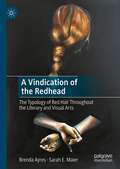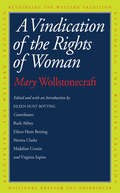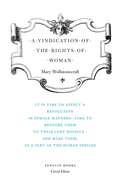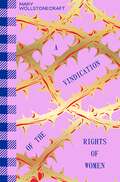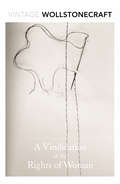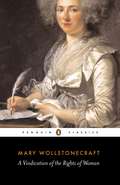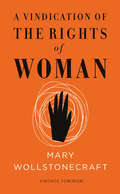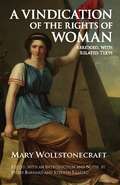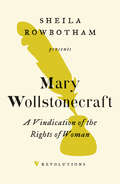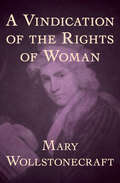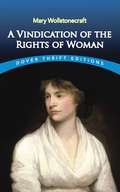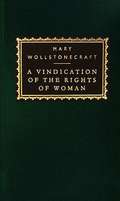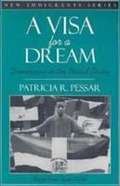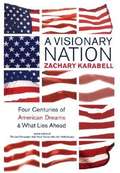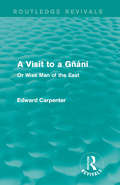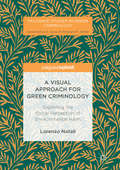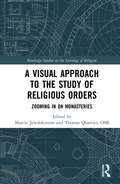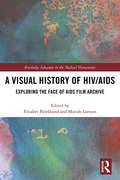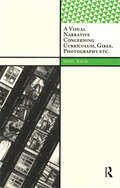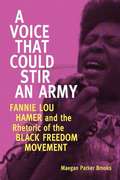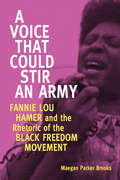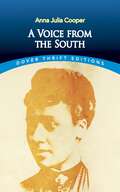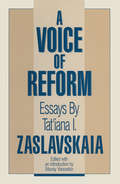- Table View
- List View
A Vindication of the Redhead: The Typology of Red Hair Throughout the Literary and Visual Arts
by Brenda Ayres Sarah E. MaierA Vindication of the Redhead investigates red hair in literature, art, television, and film throughout Eastern and Western cultures. This study examines red hair as a signifier, perpetuated through stereotypes, myths, legends, and literary and visual representations. Brenda Ayres and Sarah E. Maier provide a history of attitudes held by hegemonic populations toward red-haired individuals, groups, and genders from antiquity to the present. Ayres and Maier explore such diverse topics as Judeo-Christian narratives of red hair, redheads in Pre-Raphaelite paintings, red hair and gender identity, famous literary redheads such as Anne of Green Gables and Pippi Longstocking, contemporary and Neo-Victorian representations of redheads from the Black Widow to The Girl with the Dragon Tattoo, and more. This book illuminates the symbolic significance and related ideologies of red hair constructed in mythic, religious, literary, and visual cultural discourse.
A Vindication of the Rights of Woman
by Mary Wollstonecraft Eileen Hunt BottingMary Wollstonecraft's visionary treatise, originally published in 1792, was the first book to present women's rights as an issue of universal human rights. Ideal for coursework and classroom study, this comprehensive edition of Wollstonecraft's heartfelt feminist argument includes illuminating essays by leading scholars that highlight the author's significant contributions to modern political philosophy, making a powerful case for her as one of the most substantive political thinkers of the Enlightenment era. No other scholarly work to date has examined as closely both the ideological moorings and the enduring legacy of Wollstonecraft's groundbreaking and courageous discourse.
A Vindication of the Rights of Woman
by Mary WollstonecraftFirst published in 1792, A Vindication of the Rights of Woman was an instant success, turning its thirty-three-year-old author into a minor celebrity. A pioneering work of early feminism that extends to women the Enlightenment principle of "the rights of man," its argument remains as relevant today as it was for Woll-stonecraft's contemporaries. "Mary Wollstonecraft was not the first writer to call for women to receive a real, challenging education," writes Katha Pollitt in the new Introduction. "But she was the first to connect the education of women to the transformation of women's social position, of relations between the sexes, and even of society itself. She was the first to argue that women's intellectual equality would and should have actual consequences. The winds of change sweep through her pages." This classic work of early feminism remains as relevant and passionate today as it was for Wollstonecraft's contemporaries. This edition includes new explanatory notes.From the Trade Paperback edition.
A Vindication of the Rights of Woman (Cambridge Texts In The History Of Political Thought Ser.)
by Mary WollstonecraftA seminal book in a feminist conversation that still continues today.Now regarded as one of the founding feminist philosophers, Mary Wollstonecraft's writings have inspired conversation and action since their first publication. Wollstonecraft produced this declaration of female independence in 1792. Passionate, eloquent and forthright, it launched a scathing attack on the current understanding of women and laid out the tenets for a new vision: equal education, an end to prejudice and a chance for women to become defined by their profession, not their partner. Whereas Mary Wollstonecraft's work was received at the time with a mixture of admiration and outrage, she is now rightly viewed as a powerful matriarch of modern feminism.Part of a boldly designed series of classics, with wider margins for notes, this book is perfect for design-lovers and students alike. With bold, eye-catching graphic covers by Evi O Studio, this collection aims to introduce a selection of the most celebrated works of the last thousand years to a new audience. Featuring tales of adventure, fiction from the 19th and 20th centuries, feminist writings, and reflections on art, politics, philosophy and the origins of man, this is a small, wide-reaching and essential collection.'My own sex, I hope, will excuse me, if I treat them like rational creatures.'
A Vindication of the Rights of Woman (Cambridge Texts In The History Of Political Thought Ser.)
by Mary WollstonecraftA key work of proto-feminism, Mary Wollstonecraft's readable and impassioned argument is as relevant today as it was two hundred years ago. Before the concept of equality between the sexes was even conceived, Wollstonecraft wrote this book, a treatise of proto-feminism that was as powerful and original then as it is now. In it she argues with clarity and originality for the rational education of women and for an increased female contribution to society. It was a cry for justice from a woman with no power other than her pen and it put in motion a drive towards greater equality between men and women, a movement which continues to this day. ‘The first great piece of feminist writing’ Independent
A Vindication of the Rights of Woman (Cambridge Texts In The History Of Political Thought Ser.)
by Mary Wollstonecraft'She is alive and active - we hear her voice and trace her influence even now' Virginia WoolfWriting in an age when the call for the rights of man had brought revolution to America and France, Mary Wollstonecraft produced her own declaration of female independence in 1792. Passionate and forthright, A Vindication of the Rights of Woman attacked the prevailing view of docile, decorative femininity, and instead laid out the principles of emancipation: an equal education for girls and boys, an end to prejudice, and for women to become defined by their profession, not their partner. Mary Wollstonecraft's work was received with a mixture of admiration and outrage - one critic called her 'a hyena in petticoats' - yet it established her as the mother of modern feminism.
A Vindication of the Rights of Woman (Vintage Feminism Short Editions)
by Mary WollstonecraftDiscover Wollstonecraft’s classic feminist text in an abridged, digestible form.WITH AN INTRODUCTION BY ZOE WILLIAMS The term feminism did not yet exist when Mary Wollstonecraft wrote this book, but it was the first great piece of feminist writing. In these pages you will find the essence of her argument – for the education of women and for an increased female contribution to society. Her work made the first ripples of what would later become the tidal wave of the women’s rights movement. Rationalist but revolutionary, Wollstonecraft changed the world for women.Vintage Feminism: classic feminist texts in short form
A Vindication of the Rights of Woman: Abridged, with Related Texts
by Mary Wollstonecraft Stephen Shapiro Philip BarnardThis edition features a shrewd, annotated abridgment of Mary Wollstonecraft's A Vindication of the Rights of Woman (1792) accompanied by an array of texts that help situate the Vindication in its political, historical, and intellectual contexts. Included are key selections from Wollstonecraft's other writings; from closely related works by Burke, Paine, Godwin, Rousseau, Macaulay, Talleyrand, and Brockden Brown; and from the 1789 Declaration of the Rights of Man and Citizen and de Gouges' Declaration of the Rights of Woman and Female Citizen (1791).
A Vindication of the Rights of Woman: Strengthen The Female Mind By Enlarging It, And There Will Be An End To Blind Obedience
by Mary Wollstonecraft&“It would be an endless task to trace the variety of meannesses, cares, and sorrows, into which women are plunged by the prevailing opinion that they were created rather to feel than reason, and that all the power they obtain, must be obtained by their charms and weakness.&”—Mary Wollstonecraft Composed in 1790, Mary Wollstonecraft&’s seminal feminist tract A Vindication of the Rights of Woman broke new ground in its demand for women&’s education. A Vindication remains one of history&’s most important and elegant broadsides against sexual oppression. In her introduction, renowned socialist feminist Sheila Rowbotham casts Wollstonecraft&’s life and work in a new light.
A Vindication of the Rights of Woman: Strengthen The Female Mind By Enlarging It, And There Will Be An End To Blind Obedience
by Mary WollstonecraftThis revolutionary work from the eighteenth century is one of the first tracts of feminist philosophy Mary Wollstonecraft wrote A Vindication of the Rights of Woman in opposition to the gender norms of the eighteenth century. In this seminal text, Wollstonecraft argues that women should receive a comprehensive education in order to benefit society. Women and men, she argues, are moral equals in the eyes of God, and women, at the time that Wollstonecraft was writing, occupied an inferior station because they were trained to serve only men rather than civilization as a whole. Written in response to Charles Maurice de Talleyrand-Périgord&’s assertion that women ought only to receive a domestic education and should be confined to the home, A Vindication of the Rights of Woman was a remarkably forward-thinking political text. This ebook has been professionally proofread to ensure accuracy and readability on all devices.
A Vindication of the Rights of Woman: With Strictures On Political And Moral Subjects (Dover Thrift Editions)
by Mary WollstonecraftIn an era of revolutions demanding greater liberties for mankind, Mary Wollstonecraft (1759-1797) was an ardent feminist who spoke eloquently for countless women of her time.Having witnessed firsthand the devastating results of male improvidence, she assumed an independent role early in life, educating herself and eventually earning a living as a governess, teacher and writer. She was also an esteemed member of the radical intellectual circle that included William Godwin (father of her daughter, novelist Mary Godwin Shelley, and later her husband), Thomas Paine, William Blake, Henry Fuseli and others.First published in 1792, A Vindication of the Rights of Woman created a scandal in its day, largely, perhaps, because of the unconventional lifestyle of its creator. Today, it is considered the first great manifesto of women's rights, arguing passionately for the education of women: "Tyrants and sensualists are in the right when they endeavor to keep women in the dark, because the former want only slaves, and the later a plaything."No narrow-minded zealot, Wollstonecraft balanced passionate advocacy with a sympathetic warmth--a characteristic that helped her ideas achieve widespread influence. Anyone interested in the history of the women's rights movement will welcome this inexpensive edition of one of the landmark documents in the struggle for human dignity, freedom and equality.
A Vindication of the Rights of Woman: With Strictures on Political and Moral Subjects
by Mary Wollstonecraft Katha PolittArguably the earliest written work of feminist philosophy, Wollstonecraft produced a female manifesto in the time of the American and French Revolutions. This era induced many to reconsider not only the rights of men, but also of women, and none argued for female emancipation more eloquently or effectively than Wollstonecraft. Her strong use of analogy and philosophical language compared women of her day to both slaves and soldiers: forced to be docile and decorative. Wollstonecraft is passionate and candid as she lays out the principles feminine freedom, stating that education should be equal, there should be an end to the prejudices that proved so restrictive, and that women should be defined, not by their partner, but by their profession. Although received with both approval and anger, "A Vindication of the Rights of Woman" was ahead of its time, even modern, in its ideas, and it continues to be a foundational work for those who support women and equal rights.
A Visa for a Dream: Dominicans in the United States
by Patricia PessarA Visa for a Dream:Dominicans in the United States is part of the New Immigrant Series. This installment of the series takes an indepth look into the Dominican experience in America. Through economics, culture, gender, and generations, Patricia Pessar provides a comprehensive look into the lives of newly immigrated Dominicans, established Dominicans populations and those that remain in the Dominican Republic. (taken from the book)
A Visionary Nation: Four Centuries of American Dreams and What Lies Ahead
by Zachary KarabellIn this penetrating volume, Zachary Karabell examines the continuous thread that runs through the tapestry of the American experience -- the belief that we can create a perfect society -- and envisions what the next great era will be. Just as the Puritan vision of a city on a hill was supplanted by the Founding Fathers' vision of individuality, just as the expansive vision of a government-led Great Society was eclipsed by the New Economy of the 1990s, so too is the New Economy being replaced by what Karabell contends will be a period when community and spirituality occupy center stage.
A Visit to a Gñáni: Or Wise Man of the East (Routledge Revivals: The Collected Works of Edward Carpenter)
by Edward CarpenterOriginally published in 1911, this edition published in 1920, this text comprises of an excerpt from Carpenter’s Adam’s Peak to Elephanta, originally published in 1892, which details his travels in India and Ceylon. This excerpt in particular details his visit to a Gñáni, or religious wise man, and what he learned of their ancient wisdom-religion, which would be more recognisable as Hinduism to a modern reader. This title will be of interest to students of sociology, anthropology and religious studies.
A Visual Approach for Green Criminology: Exploring the Social Perception of Environmental Harm (Palgrave Studies in Green Criminology)
by Lorenzo NataliThis book brings the visual dimension of environmental crimes and harms into the field of green criminology. It shows how photographic images can provide a means for eliciting narratives from people who live in polluted areas - describing in detail and from their point of view what they know, think and feel about the reality in which they find themselves living. Natali makes the argument for developing a visual approach for green criminology, with a single case-study as its central focus, revealing the importance of using photo elicitation to appreciate and enhance the reflexive and active role of social actors in the symbolic and social construction of their environmental experiences. Examining the multiple interactions between the images and the words used to describe the socio-environmental worlds in which we live, this book is a call to open the eyes of green criminology to wider and richer explorations of environmental harms and crimes. An innovative and engaging study, this text will be of particular interest to scholars of environmental crime and cultural, green and visual criminologies.
A Visual Approach to the Study of Religious Orders: Zooming in on Monasteries (Routledge Studies in the Sociology of Religion)
by Marcin Jewdokimow Osb Thomas QuartierA Visual Approach to the Study of Religious Orders applies visual methods to the exploration of various facets of religious life, such as everyday lived experience, contemporary monastic identity or monastic architecture. Presenting a series of visual essays, it treats images not as simple illustrations but as an autonomous form of expression, capable of unveiling vital and developmental layers of experience, while inviting readers to examine and interpret the data themselves. The first book of its kind, it brings together case studies from various locations across Europe to demonstrate what the use of visual methodologies can contribute to social scientific research on religious orders. As such, it will appeal to scholars and students of sociology, religious studies and theology and anyone with interests in religious orders.
A Visual History of HIV/AIDS: Exploring The Face of AIDS film archive (Routledge Advances in the Medical Humanities)
by Elisabet Björklund Mariah LarssonThe Face of AIDS film archive at Karolinska Institutet, Sweden, consists of more than 700 hours of unedited and edited footage, shot over a period of more than thirty years and all over the world by filmmaker and journalist Staffan Hildebrand. The material documents the HIV/AIDS pandemic and includes scenes from conferences and rallies, and interviews with activists, physicians, people with the infection, and researchers. It represents a global historical development from the early years of the AIDS crisis to a situation in which it is possible to live a normal life with the HIV virus. This volume brings together a range of academic perspectives – from media and film studies, medical history, gender studies, history, and cultural studies – to bear on the archive, shedding light on memories, discourses, trauma, and activism. Using a medical humanities framework, the editors explore the influence of historical representations of HIV/AIDS and stigma in a world where antiretroviral treatment has fundamentally altered the conditions under which many people diagnosed with HIV live. Organized into four sections, this book begins by introducing the archive and its role, setting it in a global context. The first part looks at methodological, legal and ethical issues around archiving memories of the present which are then used to construct histories of the past; something that can be particularly controversial when dealing with a socially stigmatized epidemic such as HIV/AIDS. The second section is devoted to analyses of particular films from the archive, looking at the portrayal of people living with HIV/AIDS, the narrative of HIV as a chronic illness and the contemporary context of particular films. The third section looks at how stigma and trauma are negotiated in the material in the Face of AIDS film archive, discussing ideas about suffering and culpability. The final section contributes perspectives on and by the filmmaker as activist and auteur. This interdisciplinary collection is placed at the intersection of medical humanities, sexuality studies and film and media studies, continuing a tradition of studies on the cultural and social understandings of HIV/AIDS.
A Visual Narrative Concerning Curriculum, Girls, Photography Etc. (International Institute for Qualitative Methodology Series)
by Hedy BachThis multi-genre book is a deconstructive project that reveals the elisions, blind spots, and loci within the complex web of daily life of four schoolgirls. The girls, who attend school and actively connect their learning to the study of art, drama, ballet and music programs in and out of school, visually documented their lives both inside and outside of classrooms, using disposable cameras to create 80 to 120 photographs. One-on-one conversations with them about their images were taped and transcribed, and the analysis of these images and texts provides a description of the “evaded curriculum” within adolescent life. The research exposes pain, reveals desire and pleasure, and expresses the intensity of joy in making and creating schoolgirl culture.
A Voice That Could Stir an Army: Fannie Lou Hamer and the Rhetoric of the Black Freedom Movement (Race, Rhetoric, and Media Series)
by Maegan Parker BrooksA sharecropper, a warrior, and a truth-telling prophet, Fannie Lou Hamer (1917-1977) stands as a powerful symbol not only of the 1960s black freedom movement, but also of the enduring human struggle against oppression. A Voice That Could Stir an Army is a rhetorical biography that tells the story of Hamer's life by focusing on how she employed symbols-- images, words, and even material objects such as the ballot, food, and clothing--to construct persuasive public personae, to influence audiences, and to effect social change. <p><p> Drawing upon dozens of newly recovered Hamer texts and recent interviews with Hamer's friends, family, and fellow activists, Maegan Parker Brooks moves chronologically through Hamer's life. Brooks recounts Hamer's early influences, her intersection with the black freedom movement, and her rise to prominence at the 1964 Democratic National Convention. Brooks also considers Hamer's lesser-known contributions to the fight against poverty and to feminist politics before analyzing how Hamer is remembered posthumously. The book concludes by emphasizing what remains rhetorical about Hamer's biography, using the 2012 statue and museum dedication in Hamer's hometown of Ruleville, Mississippi, to examine the larger social, political, and historiographical implications of her legacy. <p> The sustained consideration of Hamer's wide-ranging use of symbols and the reconstruction of her legacy provided within the pages of A Voice That Could Stir an Army enrich understanding of this key historical figure. This book also demonstrates how rhetorical analysis complements historical reconstruction to explain the dynamics of how social movements actually operate.
A Voice That Could Stir an Army: Fannie Lou Hamer and the Rhetoric of the Black Freedom Movement (Race, Rhetoric, and Media Series)
by Maegan Parker BrooksA sharecropper, a warrior, and a truth-telling prophet, Fannie Lou Hamer (1917–1977) stands as a powerful symbol not only of the 1960s black freedom movement, but also of the enduring human struggle against oppression. A Voice That Could Stir an Army is a rhetorical biography that tells the story of Hamer's life by focusing on how she employed symbols—images, words, and even material objects such as the ballot, food, and clothing—to construct persuasive public personae, to influence audiences, and to effect social change. Drawing upon dozens of newly recovered Hamer texts and recent interviews with Hamer's friends, family, and fellow activists, Maegan Parker Brooks moves chronologically through Hamer's life. Brooks recounts Hamer's early influences, her intersection with the black freedom movement, and her rise to prominence at the 1964 Democratic National Convention. Brooks also considers Hamer's lesser-known contributions to the fight against poverty and to feminist politics before analyzing how Hamer is remembered posthumously. The book concludes by emphasizing what remains rhetorical about Hamer's biography, using the 2012 statue and museum dedication in Hamer's hometown of Ruleville, Mississippi, to examine the larger social, political, and historiographical implications of her legacy. The sustained consideration of Hamer's wide-ranging use of symbols and the reconstruction of her legacy provided within the pages of A Voice That Could Stir an Army enrich understanding of this key historical figure. This book also demonstrates how rhetorical analysis complements historical reconstruction to explain the dynamics of how social movements actually operate.
A Voice but No Power: Organizing for Social Justice in Minneapolis
by David ForrestExamining the work of social justice groups in Minneapolis following the 2008 recession Since the Great Recession, even as protest and rebellion have occurred with growing frequency, many social justice organizers continue to displace as much as empower popular struggles for egalitarian and emancipatory change. In A Voice but No Power, David Forrest explains why this is the case and explores how these organizers might better reach their potential as advocates for the abolition of exploitation, discrimination, and other unjust conditions.Through an in-depth study of post-2008 Minneapolis—a center of progressive activism—Forrest argues that social justice organizers so often fall short of their potential largely because of challenges they face in building what he calls &“contentious identities,&” the public identities they use to represent their constituents and counteract stigmatizing images such as the &“welfare queen&” or &“the underclass.&” In the process of assembling, publicizing, and legitimating contentious identities, he shows, these organizers encounter a series of political hazards, each of which pushes them to make choices that weaken movements for equality and freedom. Forrest demonstrates that organizers can achieve better outcomes, however, by steadily working to remake their hazardous political terrain.The book&’s conclusion reflects on the 2020 uprising that followed the police killing of George Floyd, assessing what it means for the future of social justice activism. Ultimately, Forrest&’s detailed analysis contributes to leading theories about organizing and social movements and charts possibilities for further emboldening grassroots struggles for a fairer society.
A Voice for the Animals
by Nancy White Evelyn BrooksFind out about the importance of kindness while exploring the history of the Society for the Prevention of Cruelty to Animals.
A Voice from the South (Dover Thrift Editions)
by Janet Neary Anna Julia CooperA cornerstone of black feminist and political theory, this collection of essays focuses on racial progress and women's rights. A Voice from the South, written in 1892, is regarded as the first statement of black feminism. Despite their imprint of nineteenth-century social thought, these essays possess an urgent, modern tone, characterized by an emphasis on debate and a scintillating wit. Topics include the importance of women's education as well as African Americans' economic roles and their literary representation.A noted member of Washington, D. C.'s African American community, Anna Julia Cooper (1858 - 1964) rose to prominence as a leading scholar, educator, and activist at the end of the nineteenth century. Born into slavery, she was the fourth African American woman to earn a doctoral degree, receiving a PhD in history from the University of Paris-Sorbonne in 1924. This edition includes an informative Introduction to Cooper's life and work by Janet Neary.
A Voice of Reform: Essays
by Murray Yanowitch A. Schultz Tatiana I. ZaslavskaiaFirst Published in 1989. Routledge is an imprint of Taylor & Francis, an Informa company.
